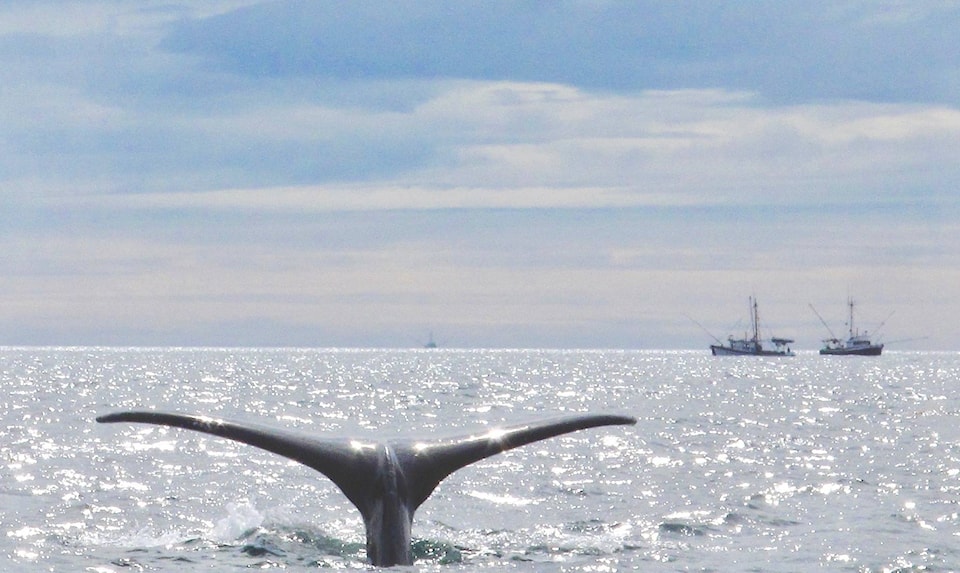Every winter the wind roars, waves break, and currents scrape the rocky slopes of SG̱aan Ḵinghlas / Bowie Seamount.
But summer is mostly quiet.
Tides rush by, but calmer waters make it easier to hear a rumble from a distant earthquake, or the low, pulsing call of a fin whale.
At the same time, it’s also easier for fish, whales and other creatures to hear the growing hum of passing ships and their propellor noise.
While the effects on marine creatures are still poorly understood, shipping noise has the potential to cause physical injury or mask other sounds they need to hear.
“During the winter, the animals are quite used to having a noisy environment around them,” says Dr. Harald Yurk, who co-authored a new study in Marine Pollution Bulletin that compares winter and summer sound levels with shipping traffic around SG̱aan Ḵinghlas, which is 180 km west of Haida Gwaii.
“Summer is the more critical time for the impact of shipping noise.”
The 6,131 km2 protected area around SG̱aan Ḵinghlas actually includes a complex of three submarine volcanoes, the tallest of which rises 3,000 metres from the ocean floor to within a couple dozen metres of the surface.
Although far offshore, the seamount summit is exposed to sunlight. Together with local upwelling of nutrient-rich waters, that makes it a rare habitat for both deep-sea and coastal life, including over 50 types of fish and at least seven species of whale.
A ban on bottom-contact fishing in the went into effect earlier this month, but the recent study of its acoustic environment suggests summer limits on shipping traffic may help protect it as well, though more research is needed first.
Dr. Yurk, who specializes in cetacean acoustics, says shipping noise in the Pacific tripled between the 1950s and 1980s and is still rising today, even though newer, more fuel-efficient ships tend to be quieter even as they grow larger in size.
“Basically, just imagine that you have a low hum in the background that’s getting louder,” he said.
Ainsley Allen, another of the study’s co-authors, noted that shipping noises tend to overlap the sounds of some marine creatures more than others. For example, she said, the lower-frequency noises tend to overlap more with the sounds made by larger baleen whales than with smaller, toothed whales.
For the SG̱aan Ḵinghlas study, an automated recorder was lowered onto a flat area of the seamount’s eastern slope, about 230 metres down. To capture the difference between summer and winter, the team analyzed sounds recorded throughout August 2011 and February 2012.
Using software to single out shipping noise, they tried to compare it with satellite-tracking data showing the path of nearby ships.
The team looked at all ships that passed within 50 km of the recorder. Only ships outfitted with an Automated Identification System transponder could be tracked — such transponders are required by law on all ships over 300 tons.
The study found shipping traffic was fairly rare in the area, with just 18 passing ships that August, and 52 in February. Most were cargo ships, a few were oil tankers heading from Alaska to Vancouver or Seattle, and one was a fishing boat that circled the top of the seamount.
Even though nearby traffic was low, the study showed it was a major contributor to overall noise at SG̱aan Ḵinghlas.
Unfortunately, Yurk said the satellite tracking was too imprecise to match the audio recordings with individual ships. AIS gear and underwater recorders improved greatly after 2013, and the recorder used in the study was also tuned to pick up marine mammal sounds, rather than ship noise.
The team would like to repeat the study, this time with two or three recorders around the seamount to better locate ships and avoid the acoustic “shadow” effect of recording from one side of the summit.
Yurk said the fact most shipping noise peaks at frequencies below 200 Hz is a reason for concern.
“These low frequencies travel really far,” he said. For example, recorders on the West Coast pick up the boom of seismic testing done in Asia or the South Pacific.
“They’re not loud, but they’re bringing that background noise up.”
Cetaceans use a wide range of frequencies, but some of the whales that fish around SG̱aan Ḵinghlas are low-frequency specialists — one of the main calls that fin whales make sounds at 20 Hz, the extreme low-end of human hearing.
“That one is meant to travel really far,” he said. Like the seismic tests, such calls can travel thousands of kilometres, crossing the entire ocean basin.
To do that, fin and other whale species also take advantage of something called “SOFAR” channels — a part of the water column between 600 and 1,200 metres down where low-frequency sound waves travel extra far without losing energy because they get “bounced” between layers of water that have different temperatures and salt levels.
The further north you go, said Yurk, the closer to the surface the SOFAR channels are, meaning that compared with places further south, it’s easier around Haida Gwaii for low-frequency shipping noise to get trapped in the same channels and muddy up the sound.
Yurk said it would be great to re-do the study, now that better resolution data is available. And while much of the research into shipping-noise impacts has focused on marine mammals, Yurk said scientists such as Dr. Francis Juanes at the University of Victoria are beginning to learn more about how fish also use sound to find prey, predators, and each other.
“Fish have pretty much the same biological problems to overcome,” he said. “There is not a whole lot of life, you can’t see very far — at 200 metres, you can’t see anywhere, basically — so sound is quite important to them.”
“It’s kind of funny saying it, but we kind of knew that fish made sound. There just wasn’t a whole lot of emphasis on paying attention to it.”
